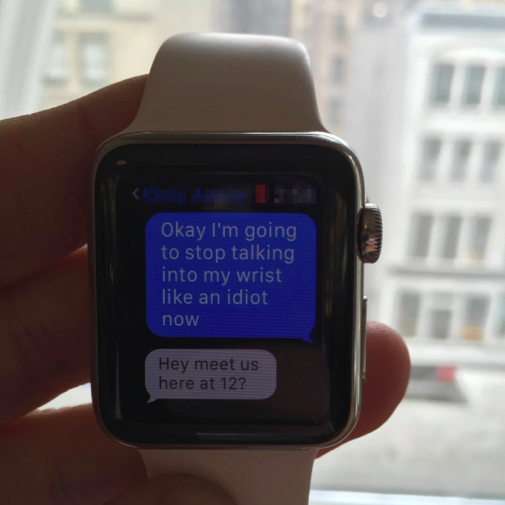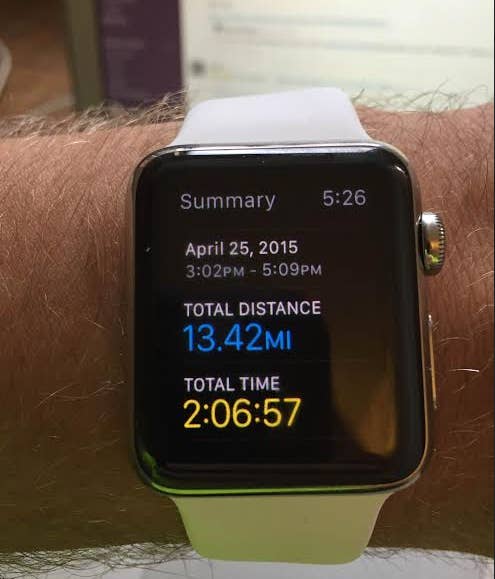

I apologize for all the images of me looking dumb that will follow in this post.
It’s a beautiful Sunday afternoon in Brooklyn and I am screaming at my own wrist. I’m late and walking with purpose down Flatbush Avenue and yelling at my watch, in a halting, robotic voice, "I’M — AT — FIFTH — AND — FLATBUSH!" People are staring at me, and not just because I’m wearing a very new, conspicuously scarce, $500 piece of metal and glass. I’m beginning to sweat. This isn’t the future I was promised.
Let me back up.
To hear Apple tell it, the real promise of the Apple Watch is to help free us from the tyranny of the company’s last paradigm-shifting invention: the iPhone. If used as intended and adopted widely, it’ll allow us to check our email, read the news, even pay for our morning coffee without ever touching our phones. But the first time I saw it, seemingly suspended in space and time, rotating elegantly as part of Apple’s March Keynote, I had a knee-jerk cringe reaction. To me, the Apple Watch looked like a notifications nightmare — a stainless steel handcuff that would make it impossible to truly unplug, a new life full of haptic reminders about all the tweets, emails, messages, and reminders impatiently waiting.
But maybe, I thought, I’m being a pompous, declinist technophobe. It’s just a watch, right? Watching Apple’s beautiful guided-tour videos of the watch, I was gradually seduced — as always seems to be the case — by the company’s masterful marketing. Perhaps this watch would, in fact, deliver on Apple’s promise and offer escape from the device I swipe open at least 100 times a day. Perhaps it isn't a tether to my job and my inbox and my obligations, but an escape from them.
There was only one way to find out. I decided to borrow an Apple Watch for a weekend and put it to the ultimate — albeit ridiculous — test. For an entire weekend, I wouldn’t be allowed to look at my phone. Instead I’d have to rely on the watch for all my Mobile Communication Needs. Apple has pitched the watch as a smaller, more portable, iPhone mirror, capable of doing nearly everything the phone can. By taking that conceit to its furthest logical extreme, I was hoping to figure out just what in the hell this watch really is.
Friday
7:30 p.m.: I get home and leave the phone in my coat because I CAN. This is liberating. I check my wrist, and my watch tells me somebody favorited one of my tweets. I refresh my email once, which is enough to see that I don’t have anything new or urgent. The whole weekend is ahead of me, and a glass of wine is in my empty stomach, and I’m feeling pretty good about this little guy. Smartphone? What smartphone? I’m a watch man now.
9:15 p.m.: I, like the rest of America, am watching ABC’s Bruce Jenner special. As I’ve become accustomed to doing during large, important television events, I try to keep up on Twitter. This is decidedly an absolute nightmare. Like most third-party apps, Twitter’s Apple Watch app doesn’t seem to be designed with living, breathing humans in mind. The app only lets me scroll through five tweets at a time, leaving me perpetually behind the conversation. To see another five I have to hit a ‘next’ button, which doesn’t always respond to my frustrated pawing. When it does, it takes a good 11 seconds to load. I give up quickly.
Saturday
9:30 a.m.: I take the watch from its "charging orb" and blearily put it on while still in bed. The watch feels like a good way to "check in" on things in the morning — just a casual glance at the major apps and email and news to get the day going. This, I’m hoping, will be where the watch reveals its worth. I swipe open the watch only to notice that I’m out of range of my phone, which is roughly 100 feet away. This is about when I realize that unless you’re looking to track your steps, the watch is basically nothing more than a pixelated timepiece when out of range of your phone. In fact, it’s kind of mind-boggling that there isn’t some kind of silly feature or game you can idly play to kill time that makes use of the haptics and accelerometers inside this gadget.
Frustrated, I get up to find my phone, which is still in my coat pocket, quickly losing battery. My watch immediately buzzes as the evening and early morning’s notifications assault my wrist. Nothing about this watch feels sexy.
12:30 p.m.: I accidentally run my watch under the sink while washing my hands. I immediately feel terrible. I know the watch is water-resistant, but it feels so fragile. Later in the weekend, while potting a plant, I get soil all over it. I feel awful, like I'm spitting in Jony Ive’s face.

3:02 p.m.: I generally do a long run on Saturdays, and I’m excited to put this thing to use as a fitness tracker. Following a few recommendations, I download Runtastic to track my pace and mileage. Mostly, I’m looking forward to get my splits and distance without having to lug my phone along. I leave it at home and set out with my watch before quickly noticing that my fitness apps don't work when out of range of the phone. While I understand it, this feels like a huge disappointment. Why have the watch if you have to bring the phone along? Luckily, Apple’s native fitness app doesn’t require the phone.
As others have noted, for all its flaws, this watch is a wonderful fitness tracker. During my two-hour run, I'm able to lift my wrist slightly and see all my stats with ease. After every mile, I get a nice little haptic pat on the wrist to celebrate the accomplishment. Sure, other fitness watches, like the ones Garmin makes, do something similar, but the Apple Watch affords you a crystal-screened, high-definition smugness that is at once douchey and thrilling. I liken it to the difference of browsing the web on a BlackBerry versus an iPhone. It’s the same internet, but one feels...superior. Afterwards, I send my racing heart rate to a colleague — the only other person I know with an Apple Watch — to gloat. He (rightly) worries I'm ill.
8:15 p.m.: I’m at a bar with my girlfriend. She gets up for a minute and I’m left alone with my beer. I reach for my phone instinctively and then stop, sighing heavily. I turn back to my watch and try to kill some time. It’s no use. All the apps are stalling out and refusing to refresh. The mail app says I haven’t received an email since 9:13 a.m., which seems wrong. I paw at the screen and accidentally change my watch face to Mickey Mouse. I am bored, and now I am wearing a child’s watch.
8:35 p.m.: Because I’ve relied solely on my watch for all manner of mobile communications all day, it dies almost without warning before I’ve had dinner. I blame this on my stunt and not on the actual battery capacity of the watch. Regardless, I’ve gone dark.
Sunday
10:15 a.m.: I have to call my parents, which I’m dreading because it means holding my wrist up to my mouth for 20 minutes. Finally I find my home’s contact in the watch and dial. I’m expecting this to be a complete disaster, resulting in me having to break my rule and use my phone. To my surprise, the phone call goes through and I hear my mom’s voice crisply over the watch's tiny speaker. She can hear me, too. We talk for 30 minutes with zero issues. This feels...kind of futuristic?

But near the end of the call, my roommate walks in the apartment and catches me pacing, talking into my wrist at a louder-than-normal volume. He shakes his head, shamefully. This has stopped being fun.
12:30 p.m.: Back to me screaming into my wrist on Flatbush Avenue. The talk-to-type software on the watch is quite good, and I feel terrible complaining about it — really, it’s kind of a modern marvel that you can talk into your watch and it turns your words into text that you can then send to other humans! But a combination of street noise and my own mumbling tendencies have left me screaming my location into the phone, and people are staring. When I finally meet up with my friends, they lament that the watch made it terribly difficult to reach me. This is clearly my fault for doing this dumb stunt, but it's also proof that watch-only communication is very difficult.
1:30 p.m.: My companions ask me to take a picture of them by some nice flowering spring trees. I oblige, but I have to use the watch’s camera feature to activate the shutter on my phone — rules are rules. I end up looking like this.

I am not proud.
A note about the camera: This feels like the biggest opportunity for abuse. Essentially, you can use the watch to control the iPhone’s camera remotely. Throughout the weekend I jokingly set it up in places that enable me to catch people I knew in candid moments. Immediately, I thought about how creeps and vile trolls could use this feature to take actual non-sanctioned creepshots of people in bathrooms and other horrible places. I hope this doesn’t happen, but it feels inevitable.
4:00 p.m.: On the way home from a movie, I decide to use the Maps feature to find a bar for a quick drink. I abandon this after 45 seconds. I head home with no intention to leave my house. I take off the watch and eye my phone. I don’t touch it but I want to. I want to so bad.
What did we learn?
The watch is neither a notifications nightmare nor a sweet release from the iPhone’s grip. At least not yet. And that’s because the watch has a lot of kinks to work out. Sometimes messages take hours to appear and arrive as a text avalanche. Other times, they don’t appear at all. Sometimes, things work perfectly and the pings are unrelenting. But mostly the tech is too wonky to act as a tether, and the third-party apps are too crummy and haphazard to meaningfully impact the watch user's life for better or for worse.
And after spending 48 hours chained to the Apple Watch as my Mobile Communications Lifeline, it became clear to me that the watch needs more than perfect tech to become a household product — it needs a paradigm shift. Like answering a call on a selfie stick, a grown man yelling into his watch in public just isn't normalized behavior — yet.
During the full 48 hours, I never had that breakthrough ‘wow’ moment: the feeling I got when I first scrolled through a 2,000 song iPod library, or when I first opened the New York Times on Safari on an iPhone. That moment — the one where the device magically seems to transform from a luxury into a necessity, the moment Apple has managed to turn into billions and billions of dollars — simply never came.
That's not to say it won't. There are a few features that are thrilling — when they work, that is. Talk-to-type is one. The ability to take a quick phone call is another. And I really loved the cutting-edge feeling of the watch as a fitness app.
And so, just as it feels wrong to get the Apple Watch dirty or wet, it also feels wrong to rail against it. It's too new, too not-quite-real for that. All told, it feels a bit like the iPhone did a decade ago: You can see a plausible future if you squint your eyes just so. That future looks enticing and cool as hell, but it’s just. not. there. yet.
As different legacy apps like Twitter figure out how to best make use of the tiny little screen and haptics and up-and-comer apps find crazy new uses for the accelerometer and ability to connect people via the wrist, a new future might open up, just as we saw with the iPhone and App Store. And just as the iPhone ushered in all manner of new behaviors, mores, and tropes, it's not all that hard to imagine a future where seeing a roomful of people talking into their watches feels as normal as seeing them squint into their phones. Yeah, this thing was kind of a pain in the ass, and yeah, I’m glad I didn’t purchase one immediately. But there’s something that feels premature about calling this a failure. No matter how dumb I looked and felt wearing it.
Disclaimer: Apple provided an Apple Watch on loan for the purposes of review.
